Colors in the Bible hold profound spiritual meanings, often symbolizing divine truths, prophetic messages, and God’s nature. Understanding these hues deepens worship and spiritual growth.
1.1. The Significance of Colors in the Bible

Colors in the Bible are not merely decorative but carry deep spiritual and prophetic meanings. They serve as symbols that convey divine truths, God’s nature, and His plan for humanity. From red symbolizing flesh and blood to blue representing the Word of God, each color is imbued with specific significance. These hues are often used to communicate complex spiritual concepts in a way that transcends language, making them universally understandable. The Bible frequently employs colors to illustrate themes such as salvation, judgment, and divine presence. Understanding their meanings enriches worship, enhances biblical interpretation, and deepens one’s connection to God’s message. Colors, therefore, play a vital role in the Bible’s narrative and spiritual teachings.
1.2. How Colors Communicate Spiritual Truths
Colors in the Bible act as visual metaphors, conveying profound spiritual truths and divine messages. They transcend language barriers, making complex ideas accessible to all. Through red, symbolizing flesh and blood, and blue, representing the Word of God, the Bible illustrates salvation, judgment, and divine presence. These hues are woven into narratives and symbols, guiding believers to deeper spiritual understanding. By aligning with God’s message, colors bridge the earthly and heavenly realms, enriching worship and fostering a connection to His divine plan.
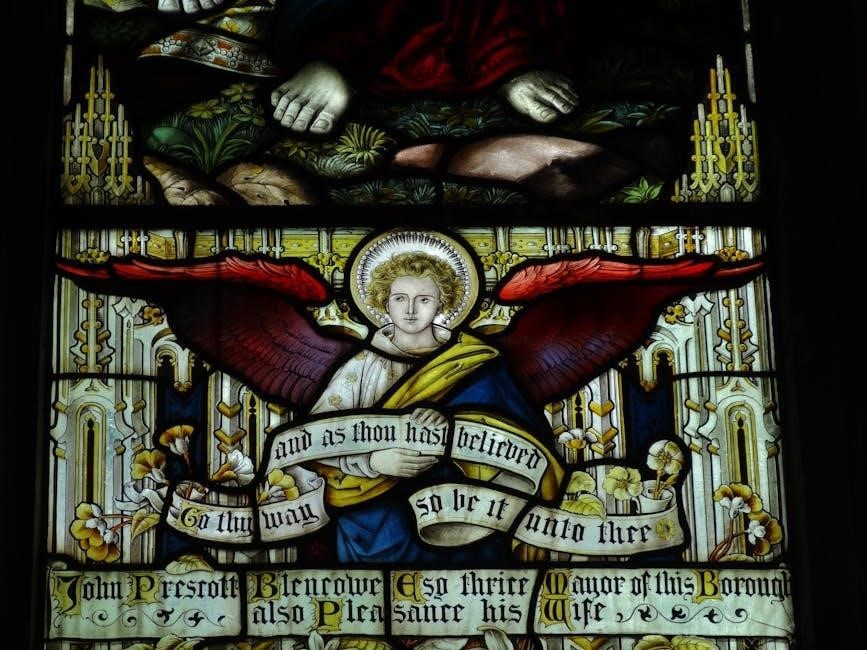
Primary Colors and Their Biblical Meanings
- Red symbolizes flesh and blood, representing life, sacrifice, and humanity’s condition.
- Blue embodies the Word of God, signifying truth, healing, and divine authority.
- Yellow reflects trials and testing, illuminating faith and spiritual refinement.
2.1. Red: Symbol of Flesh and Blood
The color red is deeply symbolic in the Bible, representing flesh and blood, which are central to human life and sacrifice. It signifies the intensity of human emotions, such as passionate love or jealousy, as seen in God’s description of Adam as “son of the red earth.” Red also symbolizes sacrifice and atonement, as the shedding of blood is a recurring motif in biblical rituals and Christ’s ultimate sacrifice. Its association with fire underscores divine judgment and refinement, while its connection to flesh highlights humanity’s frailty and the need for redemption. Red’s profound symbolism bridges the earthly and divine, making it a powerful tool for spiritual reflection and understanding God’s plan for humanity.
2.2. Blue: Representation of the Word of God
Blue holds a sacred place in biblical symbolism, representing the Word of God and its life-giving, cleansing power. It is often associated with the Holy Spirit, as seen in the “river of God” (Psalm 46:4), which flows with spiritual nourishment and renewal. Blue signifies heaven and the divine throne, emphasizing God’s sovereignty and majesty. In Ezekiel’s vision, blue surrounds God’s throne, symbolizing His glory and authority. The color also embodies trust, loyalty, and wisdom, reflecting the steadfast nature of God’s promises. By representing the Word, blue serves as a reminder of God’s truth and its transformative power in believers’ lives, offering healing and spiritual restoration to those who embrace it.
2.3. Yellow: Trials and Testing
Yellow, derived from light and gold, symbolizes trials and testing in the Bible. It represents the refining process believers endure, where faith is purified like gold in a furnace (1 Peter 1:7). Yellow signifies the intense heat of challenges, which strengthens spiritual resilience and deepens trust in God. This color is also linked to divine light and wisdom, reminding believers that trials, though difficult, are opportunities for spiritual growth. Through such experiences, individuals emerge refined, reflecting the glory of God. Yellow thus serves as a powerful reminder of endurance, hope, and the transformative power of faith during life’s trials and tribulations.
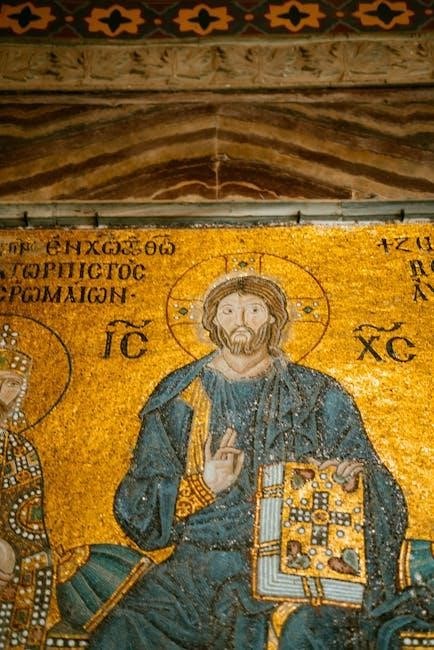
Secondary Colors and Their Spiritual Significance
Secondary colors like green, orange, and purple hold deep spiritual meanings in the Bible, representing restoration, joy, and royalty. These hues symbolize growth, divine joy, and heavenly kingship, reflecting God’s transformative power and eternal kingdom. Each color uniquely communicates aspects of His nature and promises, enriching faith and worship. They are often used prophetically to inspire and guide believers, offering vivid representations of spiritual truths and divine sovereignty.
3.1. Green: Immortality and Restoration
Green, formed by mixing yellow (trials) and blue (Word of God), symbolizes immortality and restoration in the Bible. It represents eternal life and spiritual renewal, as seen in Psalm 1:3, where the leaf does not wither. Green signifies growth, harmony, and divine providence, reflecting God’s promise of new life. In Revelation, the New Jerusalem is described with emerald, emphasizing eternal restoration. This color speaks of hope and the enduring presence of God, reminding believers of His faithfulness and the ultimate triumph over death through Christ. Green’s profound symbolism invites reflection on spiritual growth and the assurance of eternal life in Him.
3.2. Orange: Joy and Happiness
Orange, a vibrant blend of red and yellow, symbolizes joy, happiness, and divine celebration in the Bible. It reflects the warmth of God’s love and the triumph of His people. Orange is associated with feasts and rejoicing, as seen in the context of Nehemiah 8:10, where joy strengthens the people. This color embodies the exuberance of worship and communal celebration, reminding believers of the joy found in fellowship and unity with God. Orange also signifies the fruitfulness of spiritual labor and the radiance of God’s presence, encouraging believers to embrace joy as a fundamental aspect of their faith journey. Its presence in biblical contexts underscores the importance of rejoicing in the Lord’s goodness and mercy.
3.3. Purple: Kingship and Royalty
Purple holds a regal significance in the Bible, symbolizing kingship, royalty, and divine authority. It is often associated with God’s sovereignty and the majesty of His kingdom. In Exodus 28:5-6, purple is used in the ephod worn by the high priest, representing God’s divine rule. Similarly, Esther 8:15 highlights purple robes as a symbol of royal dignity. Purple also signifies justice and righteousness, as seen in the priestly garments and the robes of kings. Its rarity and costly production emphasized its exclusivity, reserved for those in positions of high authority. In Revelation, purple is linked to heavenly worship, underscoring its connection to God’s throne and eternal kingship. This color reminds believers of God’s sovereign power and the majesty of His kingdom, inspiring reverence and awe in worship and spiritual life.
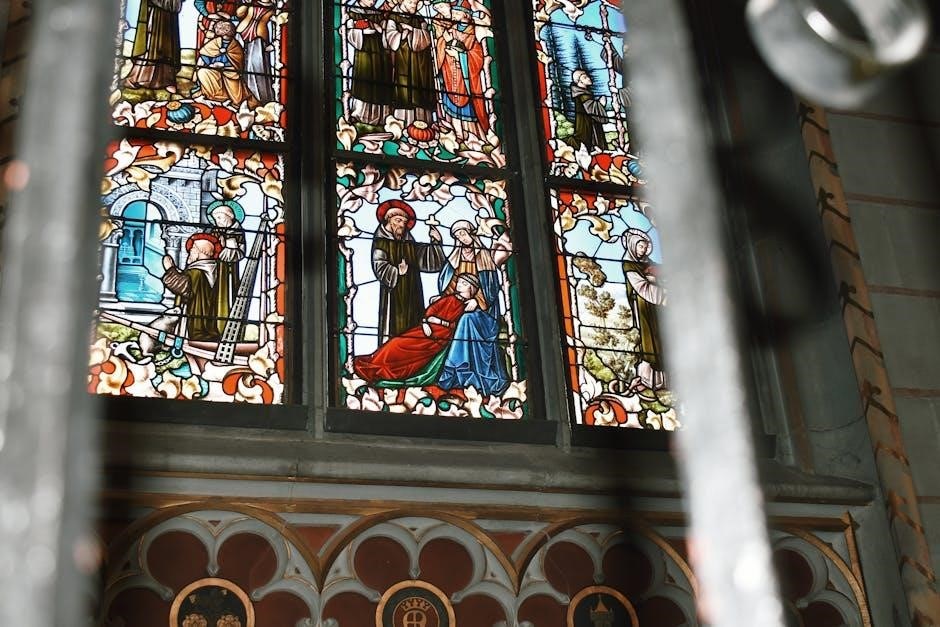
Symbolic Colors in the Bible
Symbolic colors in the Bible convey deep spiritual truths, representing God’s nature, human experiences, and divine plans. Each hue carries unique meanings that enrich biblical understanding.
4.1. Gold: Eternal Deity and Sanctification
Gold in the Bible symbolizes eternal deity and sanctification, representing God’s divine nature and holiness. It is often associated with worship, purity, and the heavenly realm. In Exodus, gold was used extensively in the construction of the Tabernacle, signifying its sacred purpose. The golden altar and vessels were consecrated for divine service, emphasizing their holy use. Gold also represents the glory of God, as seen in the description of the heavenly city in Revelation, where the streets are paved with gold. This metal’s lasting value and incorruptible nature reflect the eternal and unchanging character of God. Thus, gold is a profound symbol of divine sanctity and worship.
4.2. Silver: Redemption and Purification
Silver in the Bible symbolizes redemption and purification, reflecting its role in atoning for sins and cleansing. It is often associated with purity and refinement, as seen in its use in Temple rituals. In Exodus, silver was used for making atonement money, highlighting its connection to redemption. The process of refining silver, which involves intense heat, symbolizes spiritual purification and God’s judgment. Silver vessels in the Tabernacle, such as the basins, were used for cleansing, emphasizing its role in ritual purity. Its brilliance represents the light of God’s truth and the sanctified life of believers. Thus, silver serves as a powerful symbol of redemption, purification, and the refining work of God in His people’s lives;
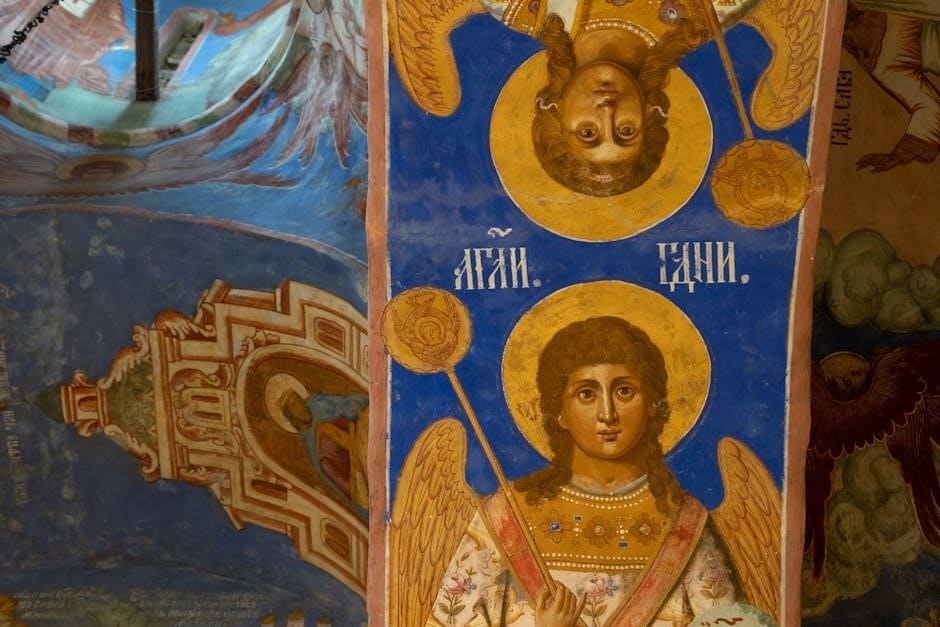
4.3. Black: Sin, Death, and Famine
Black in the Bible symbolizes sin, death, and famine, representing darkness and separation from God’s light. It often signifies mourning, as seen in Job’s sackcloth and ashes, and serves as a reminder of judgment and the consequences of sin. Black is associated with the absence of spiritual light, as in Isaiah’s description of darkness covering the earth. It also represents spiritual blindness and the hardness of the human heart. In prophetic contexts, black symbolizes famine and desolation, as in the book of Joel, where a land stripped of its abundance is likened to darkness. Black underscores the severity of sin and the need for redemption, contrasting sharply with the purity and light of God’s presence.
4.4. White: Purity and Righteousness
White in the Bible symbolizes purity, righteousness, and holiness, representing spiritual cleanliness and moral integrity. It is often associated with light and the divine presence of God. In Revelation, white robes are given to the faithful, signifying their righteous deeds and victory over sin. White also represents the Bride of Christ, clothed in fine linen, symbolizing the purity of the church. It contrasts sharply with sin and darkness, emphasizing redemption and sanctification. White is used in worship and rituals to convey reverence and the pursuit of a holy life, reflecting the believer’s desire to be set apart for God’s glory.
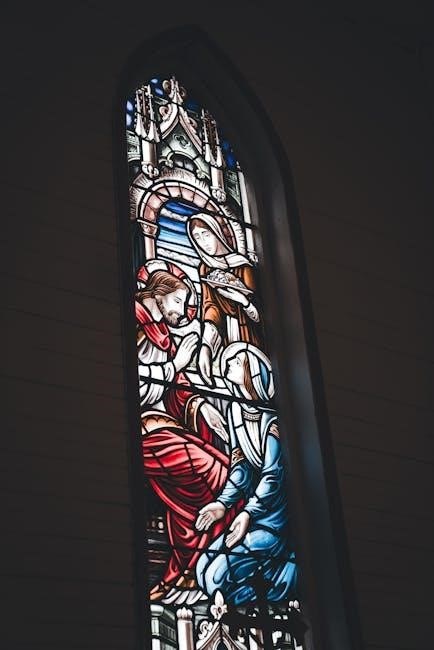
4;5. Amber/Bronze: Glory of God
Amber and bronze are symbolic of the glory of God, representing His divine presence and radiance. These colors are often associated with fire, which signifies God’s judgment and refinement. In Ezekiel 1:4 and 8:2, bronze is linked to divine manifestations, such as the appearance of God’s glory in the prophet’s visions. Amber, akin to molten metal, symbolizes the intense light of God’s presence. These hues also reflect God’s power and authority, as seen in the bronze furnishings of the tabernacle, which represented strength and endurance. The combination of amber and bronze underscores the transformative power of God’s glory, emphasizing His holiness and the refining process He brings to His people.
4.6. Brown: Humility and Service
Brown, a color closely associated with the earth, symbolizes humility, simplicity, and service in biblical contexts. It represents the ground, which is often linked to man’s earthly nature and the need for humility. In Isaiah 66:1, God describes the earth as His footstool, emphasizing the humility required to approach His presence. Brown also signifies stability and grounding, reflecting the quiet, unassuming nature of servant leadership. Jesus, as the ultimate servant, exemplified this through His earthly ministry, teaching believers to embrace humility and serve others. The color brown, therefore, reminds us of the importance of living a life grounded in faith, free from pride, and focused on serving God and others.
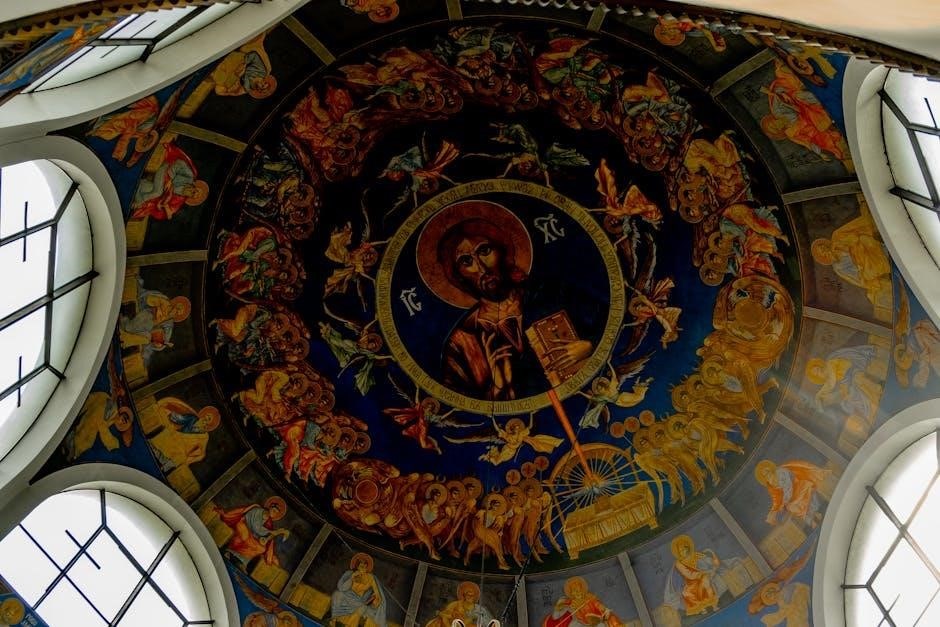
Colors in Worship and Prophetic Symbolism
Colors in worship and prophetic symbolism convey divine messages, expressing spiritual truths and emotions through their strategic use in flags, banners, and attire.
5.1. Use of Colors in Flags, Banners, and Clothing
Colors in flags, banners, and clothing are powerful tools in worship, conveying spiritual truths and prophetic messages. Blue, symbolizing the Holy Spirit and divine healing, is often used in worship flags to represent God’s presence. Green, embodying restoration and immortality, is frequently incorporated into banners to signify renewal and eternal life. Purple, associated with kingship and royalty, is used in clothing to reflect humanity’s connection to God’s divine authority. These vibrant hues create a visual language, enhancing worship experiences and aligning believers with specific biblical themes. Their strategic use in prophetic symbolism helps usher in an atmosphere of reverence, joy, and spiritual awakening, deepening the connection between worshippers and the divine.
5.2. Prophetic Meanings of Colors in Worship
Colors in worship carry profound prophetic significance, serving as visual expressions of God’s presence and divine truths. Red, symbolizing the blood of Christ and sacrifice, is often used to represent redemption and covenant. Blue, associated with the Holy Spirit, signifies healing and divine revelation. Green, embodying restoration and immortality, is used to proclaim new life and renewal. Yellow, representing trials and testing, reminds believers of God’s refining fire. Amber and bronze, symbolizing God’s glory, are often used to usher in an atmosphere of awe and reverence. Purple, representing kingship and royalty, highlights humanity’s connection to God’s divine authority. These colors, when used prophetically in worship, create a visual language that deepens spiritual connection and aligns hearts with God’s purposes, fostering an environment of joy, healing, and spiritual awakening.

Practical Applications of Biblical Color Meanings
Understanding biblical color meanings guides daily life, inspiring worship, prayer, and meditation. Colors like red, blue, and green enrich spiritual practices, fostering deeper connection and purpose.
6.1. Applying Color Symbolism in Daily Life
Applying biblical color symbolism in daily life enriches spirituality by using colors to reflect God’s truths. For instance, wearing blue reminds one of God’s grace and peace, while green symbolizes growth and restoration. Incorporating these hues in home decor or personal attire can foster a deeper connection to divine principles. Additionally, colors can be used in prayer rooms or meditation spaces to create an environment conducive to worship. By intentionally selecting colors aligned with biblical meanings, individuals can visually reinforce spiritual truths, making faith a tangible part of everyday life. This practice encourages mindfulness of God’s presence and teachings in all aspects of living.
6.2. Using Colors in Prayer and Meditation
Colors play a significant role in enhancing prayer and meditation by aligning the mind and spirit with specific biblical truths. For example, focusing on blue during prayer can symbolize trust in God’s faithfulness, while green may represent restoration and renewal. Incorporating visual aids like colored cloths or candles can deepen the experience. Additionally, meditating on yellow can evoke joy and hope, reflecting God’s presence in trials. By intentionally using colors, believers can create a meaningful connection to divine attributes, fostering a deeper, more focused prayer life. This practice invites the Holy Spirit to illuminate scriptures and personal reflections, making prayer a vibrant and transformative encounter.
Colors in the Bible are powerful symbols, revealing divine truths and enhancing spiritual understanding. They communicate God’s nature, guiding believers in worship, prayer, and daily life effectively.
7.1. Summary of Key Biblical Color Meanings
Biblical colors carry profound spiritual significance, each representing specific divine truths. Red symbolizes flesh and blood, while blue embodies the Word of God. Green signifies immortality, and yellow represents trials. Purple denotes kingship, and white stands for purity. Gold reflects eternal deity, silver signifies redemption, and black symbolizes sin. Amber and bronze represent God’s glory, while brown embodies humility. These colors, often used prophetically, deepen worship and understanding, guiding believers in prayer and meditation. Their consistent meanings across Scripture provide a rich tapestry for spiritual growth, revealing God’s nature and will through vibrant symbolism.
7.2. The Role of Colors in Deepening Spiritual Understanding

Colors play a vital role in enhancing spiritual understanding by serving as visual reminders of God’s nature and divine truths. They communicate complex spiritual concepts in a way that transcends words, making them accessible to believers. By studying biblical color symbolism, individuals can deepen their connection to Scripture, gaining insights into God’s character, promises, and plans. Colors like blue, representing the Word of God, and gold, symbolizing eternal deity, create a visual language that enriches prayer, meditation, and worship. This visual symbolism bridges the physical and spiritual realms, helping believers experience a deeper, more intimate relationship with God, while fostering a greater appreciation for His divine presence and glory.